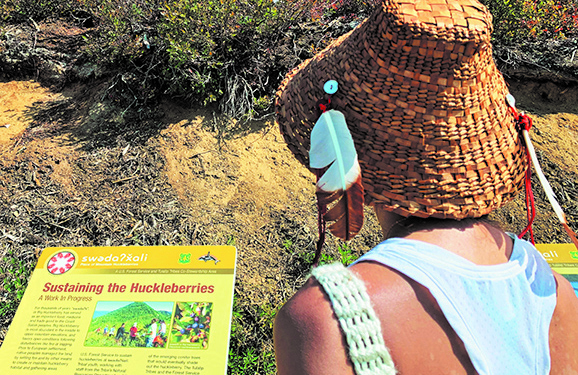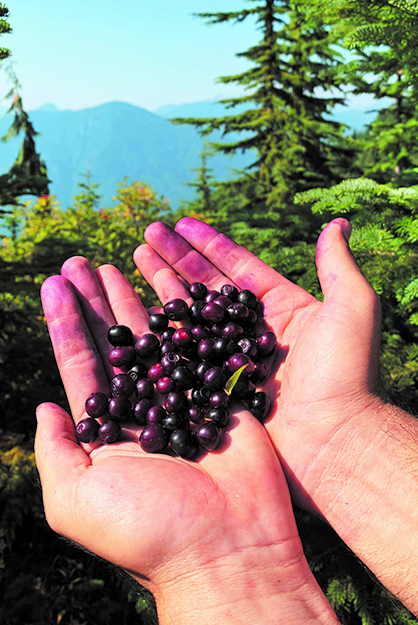
Service partnership.
By Micheal Rios, Tulalip News
For thousands of years, huckleberry has served as an important food, medicine, and trade good to the Coast Salish peoples. Mountain huckleberry is most abundant in the middle to upper mountain elevations, and favors open conditions following disturbances like fire or logging. Prior to European colonization, Native peoples managed ideal harvesting locations by using fire and other traditional means to maintain huckleberry growth for sustainable picking.
In 2011, the Tulalip Tribes began working cooperatively with the U.S. Forest Service to sustain huckleberries at a 1,280-acre parcel of land, 4,700 feet above elevation in the upper Skykomish River watershed. This particular location is one of several co-stewardship areas throughout the Mt. Baker-Snoqualmie National Forest where Tulalip collaborates with the Forest Service to preserve and maintain important cultural resources.
“The huckleberry co-stewardship work is one of the ways we are partnering with the Mt. Baker-Snoqualmie National Forest to help sustain huckleberries on the forest, and ensure that tribal members will continue to have the opportunity to gather important resources and practice traditions central to their culture,” said Tulalip Environmental Policy Analyst, Libby Nelson, back in 2016. “Treaty rights encompass more than an opportunity to pick berries, hunt game or harvest fish. Having a meaningful role on the ground, in the stewardship of these resources, helps reconnect tribal peoples to these lands and the teachings of their ancestors.”
Named swədaʔx̌ali, Lushootseed for ‘Place of Mountain Huckleberries’, this end of summer destination gives Tulalip tribal members an opportunity to walk in the steps of their ancestors and harvest the highly prized mountain huckleberry. The official announcement that the berry bounty at swədaʔx̌aliι was ripe and ready for picking came from our forestry program manager, Nick Johnson, on August 24.
“The huckleberries are ripe. The gate to swədaʔx̌ali now has a combination lock on it to enable tribal access. To get the combination of the lock please call the Admin Building front desk at 360-716-4160,” Nick’s announcement read. “After your party has gone through the gate please lock it behind you, so that any non-tribal groups don’t enter and potentially end up getting stuck behind a locked gate. The road has some deep-water bars where you’ll probably want a high-clearance vehicle to get through. Also the new gate is heavy and can take some effort to close and lock in place.”

Northwest mountain huckleberries generally ripen in the late summer and can be picked into the early fall. Huckleberry, well-known for boosting the immune system and being rich in antioxidants, has always had a strong relationship to the area’s Indigenous cultures. Coast Salish tribes consider the huckleberry to be an important dietary staple because of its medicinal properties and sweet, delicious taste.
“Huckleberry is a food and medicine to our people,” explained Tulalip elder Inez Bill. “Our ancestors visited certain areas for gathering these berries. They knew where the berries were growing, what companion plants were growing there too, and how to use them.
“Through the teachings of how we value, take care of and utilize our environment, we pass down our history and traditions, and what is important to the cultural lifeways of our people,” she continued. “This connection to the land enables us to know who we are as a people. It is a remembrance. Today, it is not only important that we continue the struggle to uphold our treaty rights, but we need to be involved in taking care of those resources our culture depends on so they will be available to future generations.”
swədaʔx̌ali is a prime example of how Tulalip is diligently working to reclaim traditional areas. Stemming directly from the Point Elliot Treaty, which secured claims to gather roots and berries in all open and unclaimed land, the ‘Place of the Mountain Huckleberries” is clear expression of Tulalip’s sovereignty.
Embracing that sovereignty is every tribal member who journeys to this ancestral harvesting area and practices their cultural traditions that continue to be passed on from one generation to the next. The mountain huckleberry is intimately tied with traditional Tulalip lifeways and culture.
Historically providing an end of summer harvest opportunity, the journey to swədaʔx̌ali strengthens a deep connection to the land. Nearly 5,000 feet up, in the Mt. Baker-Snoqualmie National Forest, berry pickers are completely immersed in the grand splendor that is the Pacific Northwest. Epic views of luscious, green-filled forestry, towering mountains, and clear waterways can be mesmerizing.
“It was a beautiful, uplifting experience. Once we hit the forest, where there were no buildings, no cars, no people, just trees…my spirit soared,” shared annual huckleberry harvester Maria Rios. “I’m fortunate to have the opportunity to speak my language, but that is only a piece of my culture. Berry picking feels natural, like I’ve always done it. The smells are intoxicating. The sounds are beautiful, from the buzzing bugs and chirping birds to the gentle breeze rustling the huckleberry leaves. These are the meaningful experiences that we all need to share in.”
“Oh my god. What a great day in the mountains!” added first time swədaʔx̌ali visitor Lena Hammons, who ventured up the mountain cautiously with her companion Jamie Sheldon. “This was my first time out gathering since I was a little girl. Definitely my first time participating in the tribal harvest. It was awesome listening to the laughter, trying to fill my bucket with huckleberries and wild blueberries. Was fortunate to get some awesome devil’s club, too, which makes my truck smell amazing. We got to wash our faces in the river on the way down. The entire experience was so healing and filled my spirit with love. All our people need to experience the beauty of swədaʔx̌ali.”
Mountain huckleberry season is short, lasting only a few weeks between August and September. The sought after super food and medicine ranges in color from red to deep blue to maroon. They are similar to a blueberry in appearance and much sweeter than a cranberry, with many people rating huckleberries as the tastiest of the berry bunch. The gate to swədaʔx̌ali will only remain accessible to Tulalip membership for a few more weeks, so don’t miss the opportunity to harvest and take in breathtaking views, while expressing your inherent tribal sovereignty.
Huckleberry Health Benefits:
- Huckleberries are full of antioxidants, compounds that are essential for improving the health of numerous systems within the body, while also preventing the development of serious health issues.
- An excellent source of vitamin A and B, huckleberries are great for promoting a healthy metabolism which in turn helps reduce the risk of stroke. They are also known to help stave off macular degeneration as well as viruses and bacteria.
- Huckleberries are associated with lowering cholesterol; protecting against heart diseases, muscular degeneration, glaucoma, varicose veins, and ulcers.
- Huckleberries are an excellent source of iron which helps build new red blood cells and helps fatigue associated with iron deficiency.
- High in vitamin C, huckleberries protect the body against immune deficiencies, cardiovascular diseases, prenatal health problems, and eye diseases.